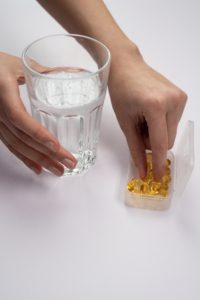Written by Jessica Patella, ND. Study concluded that among patients hospitalized for COVID-19, pre-infection deficiency of vitamin D was associated with an increase in disease severity and mortality.
 COVID-19 infection is caused by SARS-CoV-2 virus and has been the cause of a global pandemic 1. Research is emerging showing a link between vitamin D deficiency and COVID-19 infection 1,2. Previous research has found a correlation between low vitamin D levels and an increase risk of the flu and respiratory illness 1,3. Low levels of vitamin D have been recorded in hospitalized COVID-19 patients, along with increased severity of disease 1,4. Recent research compiled pre-infection vitamin D levels from medical records and found an association between lower levels of vitamin D and an increase in COVID-19 disease severity 1.
COVID-19 infection is caused by SARS-CoV-2 virus and has been the cause of a global pandemic 1. Research is emerging showing a link between vitamin D deficiency and COVID-19 infection 1,2. Previous research has found a correlation between low vitamin D levels and an increase risk of the flu and respiratory illness 1,3. Low levels of vitamin D have been recorded in hospitalized COVID-19 patients, along with increased severity of disease 1,4. Recent research compiled pre-infection vitamin D levels from medical records and found an association between lower levels of vitamin D and an increase in COVID-19 disease severity 1.
Vitamin D is most recognized for bone health, but low levels are also associated with infectious diseases because vitamin D is also an essential immune mediator 1,5. Vitamin D helps to regulate the immune system by decreasing pro-inflammatory cytokines (TNF-alpha, IL-6). Risk factors that lead to deficiency in vitamin D include low sun exposure, darker skin pigmentation or skin covering clothes, and a diet low in fish and dairy products 1,6.
The recent research included 1176 patients that were admitted to the hospital (Galilee Medical Center) from April 7, 2020 to February 4, 2021 for a COVID-19 infection. COVID-19 was confirmed by two independent PCR tests. Of these patients, 253 had records of vitamin D levels (25(OH)D) prior to COVID-19 infection. An association between pre-infection COVID-19 was divided into four categories: deficient (below 20ng/mL), insufficient (20-29.9 ng/mL), adequate (30-39.9 ng/mL) and high-normal (above 40ng/mL) levels of vitamin D. Severity of COVID infection was divided into mild, moderate, severe and critical (WHO definition) 1.
The results were as follows:
- 5% of patients had deficient levels, 14.2% had insufficient levels, 17.3% had adequate levels and 15.8% had high-normal levels of vitamin D.
- Mortality among patients with sufficient vitamin D levels was 2.3%, while mortality rate in those deficient was 25.6% (p<0.001).
- A lower vitamin D status was more common in patients with severe or critical disease (<20ng/mL [87.4%]) than in individuals with mild or moderate disease (<20ng/mL [34.3%] p<0.001).
- Patients with vitamin D deficiency were 14 times more likely to have severe or critical illness than those with a high-normal vitamin D level (OR 14; 95%CI 4, 51; p<0.001).
In conclusion, among patients hospitalized for COVID-19, pre-infection deficiency of vitamin D was associated with an increase in disease severity and mortality 1. One question would be how vitamin D levels vary based on the season, to limit this effect researchers used a “cosinor” model technique to predict annual and monthly vitamin D levels 1. Researchers state that further investigation on if and when vitamin D should be supplemented to impact outcomes of COVID-19 1.
Source: Dror, Amiel A., Nicole Morozov, Amani Daoud, Yoav Namir, Orly Yakir, Yair Shachar, Mark Lifshitz et al. “Pre-infection 25-hydroxyvitamin D3 levels and association with severity of COVID-19 illness.” Plos one 17, no. 2 (2022): e0263069.
© 2022 Dror et al. This is an open access article distributed under the terms of the Creative Commons Attribution License, which permits unrestricted use, distribution, and reproduction in any medium, provided the original author and source are credited.
Click here to read the full text study.
Posted April 11, 2022.
References:
- Dror AA, Morozov N, Daoud A, et al. Pre-infection 25-hydroxyvitamin D3 levels and association with severity of COVID-19 illness. PLoS One. 2022;17(2):e0263069. doi:10.1371/journal.pone.0263069
- Merzon E, Tworowski D, Gorohovski A, et al. Low plasma 25(OH) vitamin D level is associated with increased risk of COVID-19 infection: an Israeli population-based study. Febs j. Sep 2020;287(17):3693-3702. doi:10.1111/febs.15495
- Bergman P, Lindh AU, Björkhem-Bergman L, Lindh JD. Vitamin D and Respiratory Tract Infections: A Systematic Review and Meta-Analysis of Randomized Controlled Trials. PLoS One. 2013;8(6):e65835. doi:10.1371/journal.pone.0065835
- Jain A, Chaurasia R, Sengar NS, Singh M, Mahor S, Narain S. Analysis of vitamin D level among asymptomatic and critically ill COVID-19 patients and its correlation with inflammatory markers. Sci Rep. Nov 19 2020;10(1):20191. doi:10.1038/s41598-020-77093-z
- Charoenngam N, Holick MF. Immunologic Effects of Vitamin D on Human Health and Disease. Nutrients. Jul 15 2020;12(7)doi:10.3390/nu12072097
- Batieha A, Khader Y, Jaddou H, et al. Vitamin D status in Jordan: dress style and gender discrepancies. Annals of nutrition & metabolism. 2011;58(1):10-8. doi:10.1159/000323097

